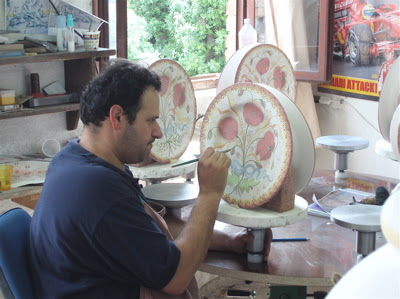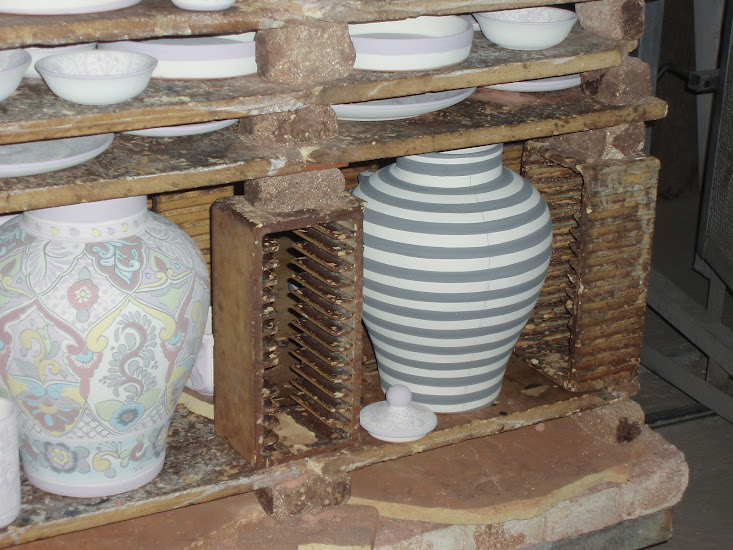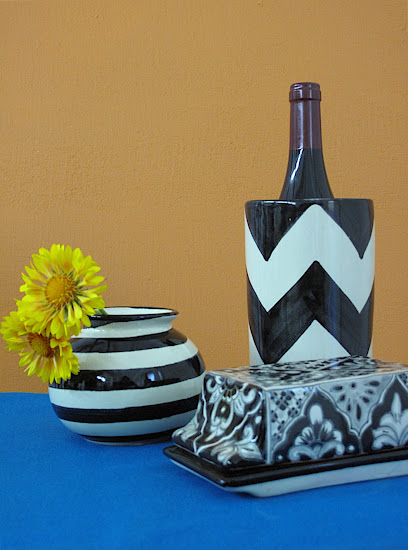 Even though all the ceramics in the Emilia Ceramics collection are handmade and handpainted, some artists focus on one of a kind ceramics more than others. Sylvie Durez’s French handmade ceramics are a perfect example. For her plates and bowls, she etches an original design onto the piece without a plan or pattern — then hand paints the piece, with women lounging, serene landscapes, or whatever else she fancies.
Even though all the ceramics in the Emilia Ceramics collection are handmade and handpainted, some artists focus on one of a kind ceramics more than others. Sylvie Durez’s French handmade ceramics are a perfect example. For her plates and bowls, she etches an original design onto the piece without a plan or pattern — then hand paints the piece, with women lounging, serene landscapes, or whatever else she fancies.
Every time I visit her Provence studio, choosing from all the many options can be quite challenging; often I wish I could just take them all!
Capelo also specializes in one of a kind handmade ceramics. He and his fellow artists in his Mexican workshop craft pieces with unusual shapes and truly touchable glazes. I especially love his vases. Take the Hawaiian vase: with its floral motifs and range of colors, this piece is beautiful empty on a shelf or full of flowers.
 Capelo’s unique bowls and trays are also fantastic examples of his one of kind work. They also make great gifts—with these handmade ceramics, you can be certain you won’t be giving something already in someone’s home.
Capelo’s unique bowls and trays are also fantastic examples of his one of kind work. They also make great gifts—with these handmade ceramics, you can be certain you won’t be giving something already in someone’s home.
 Other artists, like Gorky Gonzalez and Richard Esteban, mix one of a kind pieces in with their regular handmade ceramic collections. For example, Gorky’s Catrina plates and the amor plate allow artists to get creative with their designs. I particularly love the El Pajaro bowl with its cheerful songbird. These pieces blend nicely with the rest of Gorky’s collection. They’re incredibly detailed, sharing border motifs, color palettes, and style with his other handmade ceramics.
Other artists, like Gorky Gonzalez and Richard Esteban, mix one of a kind pieces in with their regular handmade ceramic collections. For example, Gorky’s Catrina plates and the amor plate allow artists to get creative with their designs. I particularly love the El Pajaro bowl with its cheerful songbird. These pieces blend nicely with the rest of Gorky’s collection. They’re incredibly detailed, sharing border motifs, color palettes, and style with his other handmade ceramics.
Richard’s one of a kind French handmade ceramics are also tied together by color and feel. Whether it’s a striking black tall pitcher, quirky polka dot planter, or striped serving platter, these ceramics definitely embody the spirit of his country home with a modern edge. I love his tall teal vase and its etching; this is another example of a vase that looks wonderful empty or full.
Of course, the one downside to all these handmade ceramics is once they are sold, they’re gone. It can be hard to not fall in love with every one, but if I kept them all, I’d have no room left in my home. That’s why I’m always happy to share them with you as well as hear from people about their new handmade ceramics when they receive them. Have a story about some handmade ceramics you love and how you use them? Comment below and please share it with us all!































































